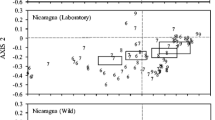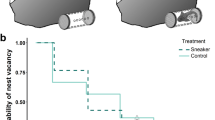Abstract
This article considers two game-theoretic models of parental care which take into account the feedback between patterns of care and the operational sex ratio. Attention is paid to fish species which care for their young by mouthbrooding, in particular to St. Peter’s Fish. It is assumed here that individuals can be in one of the two states: searching for a mate or breeding (including caring for their offspring). However, the sets of states can be adapted to the physiology of a particular species. The length of time an individual remains in the breeding state depends on the level of care he/she gives. According to one model, parents make their decision regarding the amount of care they give simultaneously. Under the second model, one individual in a pair (for convenience, the female) makes her decision before the male makes his decision. When in the searching state, individuals find partners at a rate dependent on the proportion of members of the opposite sex searching. These rates are defined to satisfy the Fisher condition that the total number of offspring of males equals the total number of offspring of females. The operational sex ratio is not defined exogenously, but can be derived from the adult sex ratio and the pattern of parental care. The results obtained go some way to explain the variety of parental care behaviour observed in fish, in particular the high frequency of male care, although further work is required to explain the exact patterns observed.
Access this chapter
Tax calculation will be finalised at checkout
Purchases are for personal use only
Similar content being viewed by others
References
Balshine-Earn S (1997) The benefits of uniparental versus biparental mouth brooding in Galilee St. Peter’s fish. J Fish Biol 50:371–381
Balshine-Earn S, Earn DJD (1997) An evolutionary model of parental care in St. Peter’s fish. J Theor Biol 184:423–431
Broom M, Ruxton GD (1998) Evolutionarily stable stealing: Game theory applied to kleptoparatism. Behav Ecol 9(4):397–403
Clutton-Brock TH, Parker GA (1992) Potential reproductive rates and the operation of sexual selection. Q Rev Biol 67:437–456
Dawkins R, Carlisle TR (1976) Parental investment and mate desertion: A fallacy. Nature 262: 131–133
Emlen ST, Oring LW (1977) Ecology, sexual selection, and the evolution of mating systems. Science 197:215–223
Eriksson A, Lindgren K, Lundh T (2004) War of attrition with implicit time costs. J Theor Biol 203:319–332
Fishelson L, Hilzerman F (2002) Flexibility in reproductive styles of male St. Peter’s tilapia Sarotherodon Galilaeus (Cichlidae). Environ Biol Fishes 63:173–182
Grafen A, Sibly R (1978) A model of mate desertion. Anim Behav 26:645–652
Grüter C, Taborsky B (2005) Sex ratio and the sexual conflict about brood care in a biparental mouthbrooder. Behav Ecol Sociobiol 58:44–52
Gubernick DJ, Teferi T (2000) Adaptive significance of male parental care in a monogamous mammal. Proc R Soc Lond B 267:147–150
Hayward A, Gillooly JF (2011) The cost of sex: Quantifying energetic investment in gamete production by males and females. PLoS ONE 6(1):e16,557
Houston AI, McNamara JM (2002) A self-consistent approach to paternity and parental effort. Phil Trans R Soc Lond B 357:351–362
Houston AI, McNamara JM (2005) John Maynard Smith and the importance of consistency in evolutionary game theory. Biol Philos 20:933–950
Jennions M, Polakow D (2001) The effect of partial brood loss on male desertion in a cichlid fish: An experimental test. Behav Ecol 12(1):84–92
Jennions MD, Kokko H (2010) Sexual selection. In: Westneat DF, Fox CW (eds) Evolutionary behavioral ecology. Oxford University Press, Oxford, pp 343–364
Kokko H, Jennions M (2003) It takes two to tango. Trends Ecol Evol 18:103–104
Kokko H, Jennions MD (2008) Parental investment, sexual selection and sex ratios. J Evol Biol 21:919–948
Kokko H, Rankin DJ (2006) Lonely hearts or sex in the city? density-dependent effects in mating systems. Phil Trans R Soc B 361:319–334
Maynard Smith J (1977) Parental investment: A prospective analysis. Anim Behav 25:1–9
Maynard Smith J (1982) Evolution and the theory of games. Cambridge University Press, Cambridge
McNamara JM, Székely T, Webb JN, Houston AI (2005) A dynamic game-theoretic model of parental care. J Theor Biol 205:605–623
Ramsey DM (2010) A large population parental care game: Polymorphisms and feedback between patterns of care and the operational sex ratio. J Theor Biol 266:675–690
Ros AFH, Zeilstra I, Oliveira RF (2003) Mate choice in the Galilee St. Peter’s fish, Sarotherodon Galilaeus. Behaviour 140:1173–1188
Trivers RL (1972) Parental investment and sexual selection. In: Campbell B (ed) Sexual selection and the descent of man 1871–1971. Aldine Press, Chicago, pp 139–179
Webb JN, Houston AI, McNamara JM, Székely T (1999) Multiple patterns of parental care. Anim Behav 58:983–993
Wright HWY (2006) Paternal den attendance is the best predictor of offspring survival in the socially monogamous bat-eared fox. Anim Behav 71:503–510
Yamamura N, Tsuji N (1993) Parental care as a game. J Evol Biol 6:103–127
Yaniv O, Motro U (2004) The parental investment conflict in continuous time: St. Peter’s fish as an example. J Theor Biol 228:377–388
Acknowledgements
The author is grateful for the support of Science Foundation Ireland under the BIO-SI project (no. 07MI012).
Author information
Authors and Affiliations
Corresponding author
Editor information
Editors and Affiliations
Appendices
Appendix 1: Stability Conditions in Game with Simultaneous Moves
The left-hand side of each inequality is the reproduction rate of males (which is the reproduction rate of the females divided by the ASR), the first entry on the right-hand side is the reproduction rate of a mutant male and the second entry is the reproduction rate of a mutant female divided by the ASR.
Only male parental care is an ESS if
Only female parental care is an ESS if
Parental care by both sexes is an ESS if
Appendix 2: Stability Conditions in Game with Asynchronous Moves
No parental care with unconditional desertion by males, [(D, D), D], is neutrally stable when
This strategy profile is strongly stable when, in addition
Biparental care with unconditional care from males, [(C, C), C], is neutrally stable when
The condition required for strong stability, i.e.
is a weaker condition than Condition (8.50). Hence, if [(C, C), C] is neutrally stable, then it is strongly stable.
Finally, it can be shown that [(C, D), C], i.e. biparental care with male care being conditional on the female giving care, is neutrally stable when
This strategy profile is strongly stable when, in addition
Rights and permissions
Copyright information
© 2013 Springer International Publishing Switzerland
About this chapter
Cite this chapter
Ramsey, D.M. (2013). A Large Population Parental Care Game with Asynchronous Moves. In: Křivan, V., Zaccour, G. (eds) Advances in Dynamic Games. Annals of the International Society of Dynamic Games, vol 13. Birkhäuser, Cham. https://doi.org/10.1007/978-3-319-02690-9_8
Download citation
DOI: https://doi.org/10.1007/978-3-319-02690-9_8
Published:
Publisher Name: Birkhäuser, Cham
Print ISBN: 978-3-319-02689-3
Online ISBN: 978-3-319-02690-9
eBook Packages: Mathematics and StatisticsMathematics and Statistics (R0)




